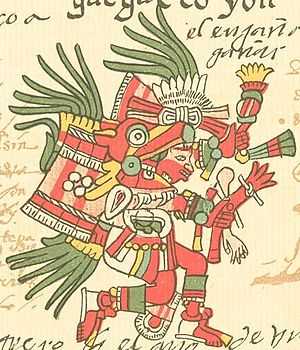Huehuecoyotl

In Aztec mythology, Huehuecóyotl [weːweˈkojoːt͡ɬ] (from huēhueh [ˈweːweʔ] "very old" (literally, "old old") and coyōtl [ˈkojoːt͡ɬ] "coyote" in Nahuatl) is the auspicious god of music, dance, mischief and song of ancient Mexico. He is depicted in the Codex Borbonicus as a dancing coyote with human hands and feet, accompanied by a human drummer. The name "Very old coyote" conveyed positive meanings for the Aztec populace; coyotes were an Aztec symbol of astuteness and worldly-wisdom, pragmatism and male beauty and youthfulness. The prefix "huehue" which in Nahuatl means "very old" was attached to gods in Aztec mythology that were revered for their old age, wisdom, philosophical insights and connections to the divine. Although often appearing in stories as male, Huehuecóyotl can be gender changing, as many of the offspring of Tezcatlipoca. He can be associated with indulgence, male sexuality, good luck and story-telling. One of his prominent female lovers was Temazcalteci (also Temaxcaltechi), the goddess of bathing and sweatbaths (temazcalli), also known as Mexican sauna and Xochiquetzal, the goddess of love, beauty, female sexuality, prostitutes, flowers and young mothers. His male lovers included Opochtli, the left-handed god of trapping, hunting and fishing and Xochipilli, the god of art and games and the patron of homosexuals and male prostitutes of Mesoamerica.
As all Aztec deities, Huehuecóyotl was dualistic in his exercise of good and evil. He was perceived as a balanced god; depictions of his dark side include a coyote appearance (non-human) with black or yellow feathers, as opposed to the customary green feathers.
In most depictions of Huehuecóyotl, he is followed by a human drummer or groups of humans that appear to be friendly to him (as opposed to worshipping), which is exceptional in Mesoamerican culture. In the minds of the Aztec, the close relationship between Huehuecóyotl and humans created a favoritism towards his worship due to the practical as well as spiritual benefits perceived by the ancient Mexicans, who saw other gods either as too far away from them or too lowly; therefore Huehuecóyotl was associated with balance of the old (huehue) and the new (coyotl), the worldy and the spiritual, the male and the female, as well as youth and old age, in modest parallel with the Mayan Hunab Ku or the Chinese Yin-yang symbol.
Stories derived from the Codex Telleriano-Remensis make him a benign prankster, whose tricks are often played on other gods or even humans but tended to backfire and cause more trouble for himself than the intended victims. A great party-giver, he also was alleged to foment wars between humans to relieve his boredom. He is a part of the Tezcatlipoca (Smoky Mirror) family of the Mexica gods, and has their shapeshifting powers.
Those who had indications of evil fates from other gods would sometimes appeal to Huehuecóyotl to mitigate or reverse their fate. Huehuecóyotl shares many characteristics with the trickster Coyote of the North American tribes, including storytelling and choral singing.
The fourth day of the thirteen day Mexican week belonged to Huehuecóyotl.
He was the only friend to Xolotl who is the god of twins, sickness and deformity and accompanies the dead to Mictlan (the underworld of Aztec mythology). Their association is born from the canine nature of both gods.
